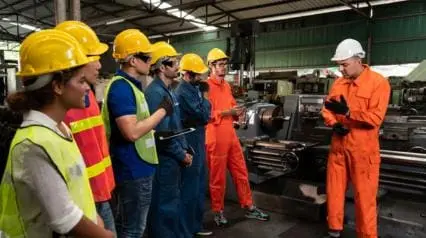What is a Construction Safety Program?
A construction safety program refers to the set of rules, processes, controls, and procedures in place to protect workers in a construction site. It should include all the policies and procedures necessary to keep workers safe throughout all your operations. These programs establish a basis for risk identification, assessments, and training, which is why they are very important for the construction industry.
Most construction operations have a construction safety program in place throughout the entire project. This is why the program must cover all bases, from the prep work at the start of the project, all the way to the procedures necessary to finish the job. While it’s a pretty comprehensive program to create and implement, it’s absolutely essential for worker safety.
Importance
There are many reasons you should implement a comprehensive safety program during construction projects. The first, and most important reason is that a safety program protects your workers. There are many risks that workers face every day they show up at the site, which is why it’s on the team to create a program that eliminates and mitigates different risks so that your employees are safe throughout operations.
A comprehensive safety program establishes a baseline for the team to follow throughout the entire project. Since a construction safety program includes the best practices and standard procedures for workers to follow, you can reduce the chances of human error, which is a major hazard on-site.
Safety should be a top priority for project managers when they start a project. The safer your employees are, the more efficient and productive your team. Accidents and safety issues can cost a lot of time and drain your resources, so protect your workers and your project by implementing a construction safety program.
Elements of a Construction Safety Program
Every project requires a unique construction safety program. It’s important to customize the program to the project’s needs along with the different equipment and procedures involved in your daily tasks. That way, you ensure that the program covers all major concerns and addresses the main hazards that your workers face on the job.
That said, there are also a few key elements that you’ll need in any construction safety program, which include the following:
Leadership Commitment and Employee Involvement
A successful organization and project requires alignment and involvement from all levels. The first step in establishing a safety program is making sure that everyone is committed to maintaining a safety culture in their operations. The more committed the management team is to the project, the easier it will be to get everyone else on board.
Hazard Identification and Risk Assessment
To establish a construction safety program, you need to get a proper idea of the different risks and hazards that your workers face. This is why a key element of these programs is hazard and risk identification. Once you identify the hazards, it’s important that you assess and rank them based on severity and importance. That way, it will be much easier to determine your priorities when building a safety program.
Safety Policies and Procedures
Of course, no program is complete without policies and procedures. When building your safety program, make sure that the safety policies and procedures you want to implement are designed to mitigate and reduce the unique risks and hazards your workers face.
The reason you need to conduct your risk assessment before establishing safety policies is that the assessment gives you an idea of the risks and hazards you need to build policies around. So, always make sure your safety procedures and best practices are established with your project’s risks in mind.
Create Your Own Construction Safety Program Checklist
Eliminate manual tasks and streamline your operations.
Get started for FREETraining and Education
Another key element of a safety program is training. The best way to ensure that your workers follow the safety program is to train them in the best practices and educate them on the importance of following safety procedures. So, before letting any employee out onto the field, make sure they’ve gone through adequate and comprehensive training.
Personal Protective Equipment (PPE)
PPE is an essential asset in all construction projects, as they give your workers an essential safety layer to protect them against hazards at construction sites. This is why it’s important to set the types of PPE that employees must wear during work and set up a safety program that ensures they always wear PPE.
Equipment Safety and Maintenance
Faulty and outdated equipment can put your employees in unnecessary danger. This is why you must make sure that your safety program includes a maintenance routine for your equipment and other company assets. That way, you ensure that all the equipment is safe and functional, protecting your workers and your operations.




